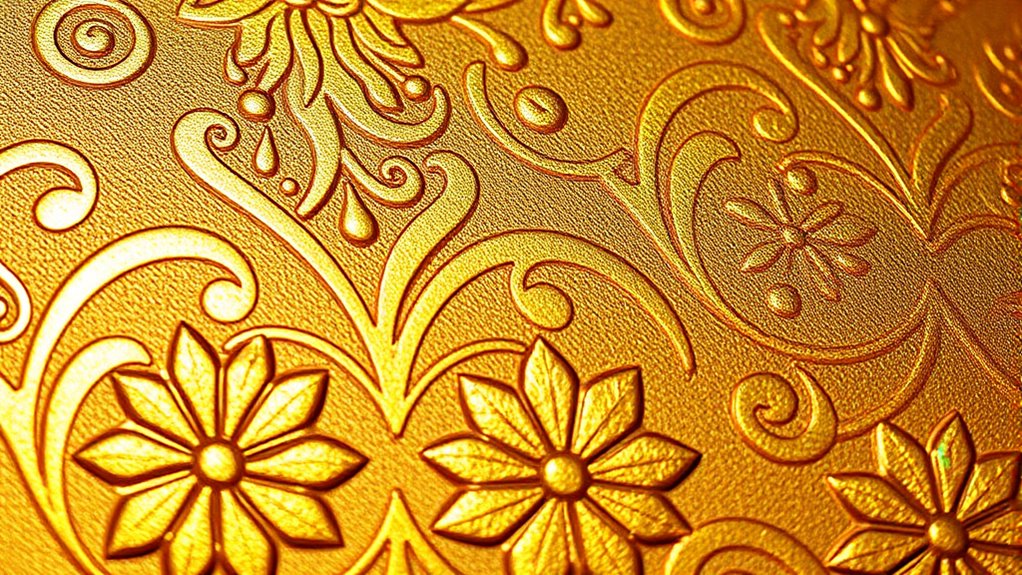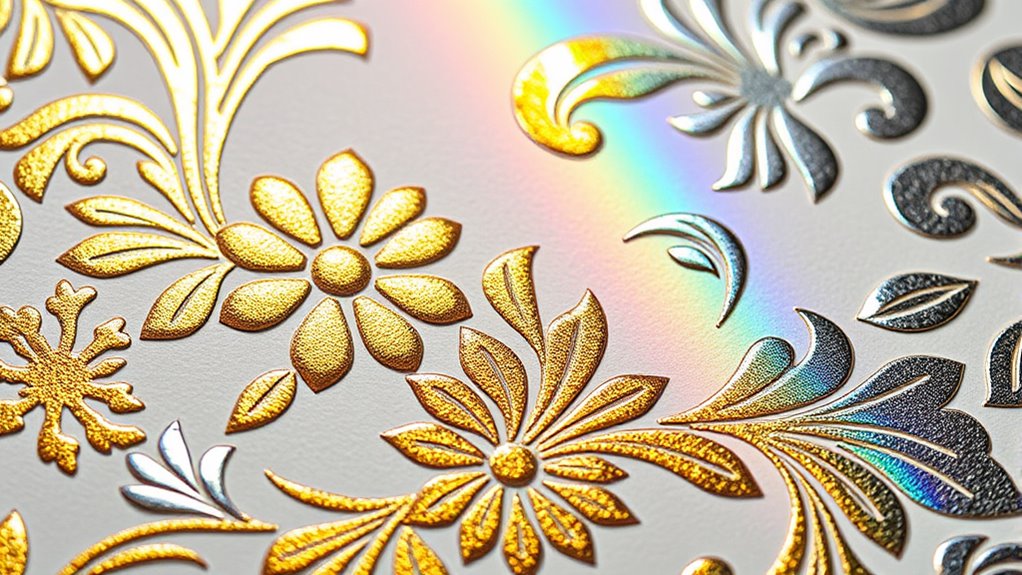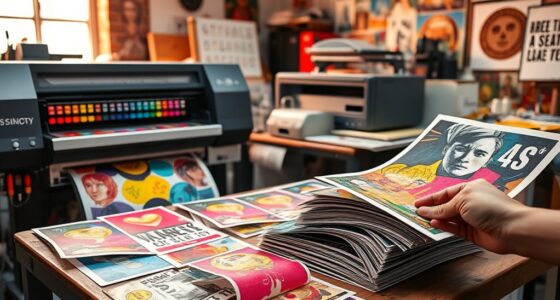Specialty finishes like foil stamping, embossing, and holographic effects help you transform ordinary surfaces into eye-catching masterpieces. Foil adds metallic shine, embossing creates a raised, tactile feel, and holographic effects deliver shifting, iridescent colors. Combining these techniques can boost visual appeal and make your designs stand out with a luxurious vibe. Want to explore how these finishes can elevate your projects? Keep going to uncover more ideas and tips.
Key Takeaways
- Specialty finishes like foil, embossing, and holographic effects enhance surface appeal with metallic shine, texture, and dynamic visual effects.
- Foil stamping applies metallic or pigmented foil to highlight logos and borders with reflective, eye-catching results.
- Embossing creates a three-dimensional, tactile effect by raising specific areas for added depth and sophistication.
- Holographic effects introduce shifting colors and iridescence, creating a futuristic, mesmerizing appearance.
- Combining these techniques elevates packaging, branding, and artwork by adding luxury, visual interest, and sensory appeal.

Have you ever wondered how to make a surface truly stand out? Specialty finishes like foil, embossing, and holographic effects are perfect tools to elevate your design game. These techniques add depth, shine, and a tactile dimension that instantly grab attention. When you incorporate metallic accents, you create a sleek, modern aesthetic that catches the light from every angle. Metallic finishes are especially striking on textured surfaces, where the combination of shine and tactile variation creates a dynamic visual experience. Imagine a brochure with embossed metallic foil that highlights specific elements—this not only emphasizes important details but also provides a luxurious feel that invites touch and exploration.
Foil stamping is a versatile method that applies thin metallic or pigmented foil to a surface using heat and pressure. It’s ideal for adding a pop of shimmer to logos, headlines, or decorative borders. The reflective quality of metallic foils makes them stand out against matte backgrounds, creating a striking contrast that draws the eye. When combined with textured surfaces, foil stamping enhances the visual interest by adding contrast between the smooth, reflective foil and the rough or embossed background. This interplay of textures and finishes results in a sophisticated look that’s hard to ignore. Plus, foil can be customized in a variety of colors, from classic gold and silver to vibrant hues, giving you endless creative options.
Embossing, on the other hand, raises specific areas of your material, creating a three-dimensional effect. This tactile technique is especially effective for emphasizing logos, patterns, or borders. When you pair embossing with metallic accents, the raised areas catch light, adding a shimmering effect that makes your design pop. Applying embossing to textured surfaces amplifies the sense of depth and richness, giving your project a tangible quality that’s both elegant and engaging. Whether you’re working on packaging, business cards, or artwork, embossing adds an element of craftsmanship and sophistication that’s hard to replicate with flat printing.
Holographic effects push the boundaries even further by introducing shifting colors and iridescent finishes that change as you move around the surface. These finishes create a futuristic vibe, making your project stand out in any setting. Combining holographic effects with textured surfaces results in a mesmerizing interplay of light and texture that captivates viewers. When you utilize specialty finishes like foil, embossing, or holographic effects, you’re not just decorating—you’re creating an experience. These techniques turn ordinary surfaces into extraordinary statements, ensuring your design leaves a lasting impression. Incorporating specialty finishes can elevate a simple design into a luxurious and memorable visual experience.
Frequently Asked Questions
How Do Specialty Finishes Impact Printing Costs?
Specialty finishes like foil, embossing, and holographic effects usually cause a cost increase because they require additional materials and specialized equipment. You should consider these effects carefully within your budget considerations, as they can substantially raise printing costs. While they add visual appeal and value, it’s important to weigh the impact on your overall project expenses to ensure they align with your financial plan.
Are Foil, Embossing, and Holographic Effects Environmentally Sustainable?
Imagine you’re in a Victorian workshop, yet today’s specialty finishes like foil, embossing, and holographic effects can be eco-friendly. They vary in sustainability; traditional methods may use non-recyclable materials, but you can choose eco-friendly alternatives and sustainable production methods. These options reduce environmental impact, making your print projects more sustainable. By selecting greener finishes, you help protect the planet while still achieving stunning visual effects.
Which Finishes Are Most Durable for Outdoor Applications?
For outdoor applications, you should choose finishes with strong weather resistance and UV stability. Embossing generally offers good durability, while foil and holographic effects may fade or peel over time if not specially treated. To guarantee longevity, opt for finishes that are specifically formulated to withstand sunlight, rain, and other environmental factors. This way, your design stays vibrant and intact longer outdoors.
Can These Finishes Be Applied to All Types of Paper and Materials?
You might wonder if these finishes suit every material, and the answer is no. While they offer impressive material versatility, not all papers are compatible. Some surfaces can’t hold the foil, embossing, or holographic effects well, leading to poor adhesion or damage. To guarantee a stunning result, you must assess each material’s compatibility carefully. Trust your expertise to select the right finishes for your project’s unique paper and material needs.
What Are the Latest Innovations in Specialty Finishing Technologies?
You’ll find that the latest innovations in specialty finishing technologies include innovative application techniques that enhance precision and durability. These advancements also offer customizable texture options, allowing you to tailor finishes to your design needs perfectly. New methods like digital foil stamping and advanced holographic effects enable you to achieve more intricate, eye-catching results. These innovations give you greater flexibility and creative control, making your projects stand out with unique, high-quality finishes.
Conclusion
Now that you know about foil, embossing, and holographic effects, it’s clear these finishes can truly transform your designs into timeless art. Think of them as the secret sauce, elevating your work beyond the mundane—like discovering a hidden room in your favorite vintage mansion. Don’t be afraid to experiment and add that extra sparkle. After all, in a world full of pixels, a touch of craftsmanship can still make your project unforgettable.









